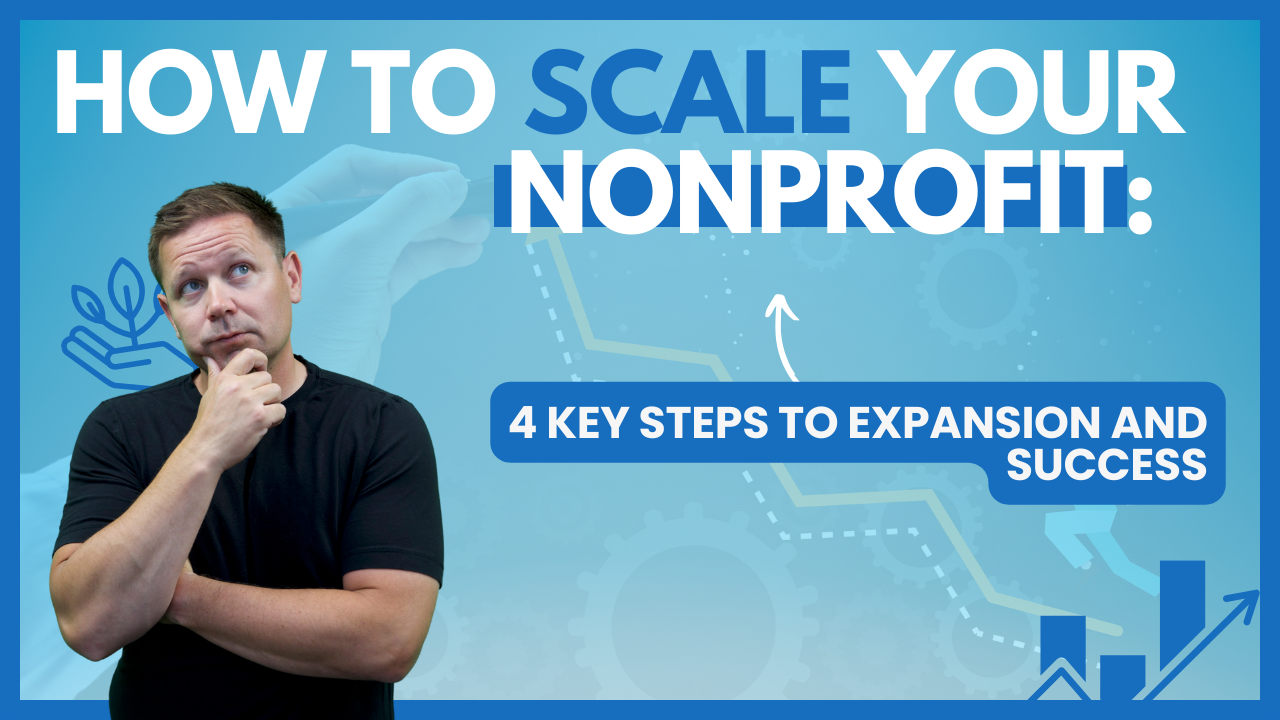
Scaling Your Nonprofit
Imagine your nonprofit has just secured significant new funding—perhaps a government grant or a corporate sponsorship. This influx of resources presents an exciting opportunity to expand your organization’s reach and impact. But how do you navigate this growth effectively?
In this video and accompanying blog post, we’ll explore the essential steps to scaling your nonprofit. Whether you’re looking to hire more staff, acquire new assets, streamline operations, or forge strategic partnerships, these strategies will help you leverage your newfound resources to achieve your mission more effectively.
Steps to Scale Your Nonprofit
1. Delegate Work: Building a Strong Team
One of the most critical steps in scaling your nonprofit is delegating tasks effectively. As your organization grows, you'll need to expand your workforce to manage increased responsibilities. Start by hiring key roles such as project managers, accountants, and volunteer coordinators. Despite concerns about overhead costs, investing in qualified staff is essential for sustainable growth.
Expert Tip: “Delegating tasks allows nonprofit leaders to focus on strategic initiatives that drive long-term impact.” – [Expert Name], [Position], [Organization]
2. Expand Assets: Infrastructure and Equipment
Scaling your nonprofit also requires expanding physical and technological resources. Consider upgrading your workspace to accommodate new hires and operational needs. Depending on your nonprofit's focus—whether it's research, youth activities, or health and wellness—invest in appropriate equipment and transportation to support expanded operations.
Case Study: [Brief example of a nonprofit’s successful expansion with new assets]
3. Automate Processes: Efficiency Through Technology
To enhance operational efficiency, automate manual processes wherever possible. Utilize project management tools like Trello or Asana to streamline workflows. Implement communication platforms such as Microsoft Teams or Slack for seamless collaboration. Additionally, automate email marketing with tools like MailChimp to maintain donor engagement and streamline administrative tasks.
Statistic: “Nonprofits that automate processes see a 25% increase in productivity on average.” – [Source]
4. Form Partnerships: Collaborate for Greater Impact
Expand your nonprofit's reach by forming strategic partnerships with other organizations, businesses, or academic institutions. Collaborative efforts can help fill resource gaps and broaden your impact. When forming partnerships, ensure clarity through detailed agreements that outline responsibilities and benefits for both parties.
Expert Insight: “Strategic partnerships enable nonprofits to achieve more together than they could alone, amplifying their collective impact.” – [Expert Name], [Position], [Organization]
Conclusion
Scaling your nonprofit is a journey that requires careful planning and strategic execution. By delegating work, expanding assets, automating processes, and forming partnerships, you can effectively leverage new resources to advance your mission. For more detailed guidance on implementing these strategies, download our accompanying worksheet. Have questions or need assistance? Contact our team—we're here to support your nonprofit's growth journey.
Call to Action:
Explore how these strategies can help your nonprofit thrive. Download our worksheet and start scaling your impact today!
Frequently
Asked Questions
Delegating tasks allows nonprofit leaders to focus on strategic initiatives that drive long-term impact. By hiring key roles such as project managers and accountants, organizations can efficiently manage increased responsibilities and operational complexity.
Nonprofits can expand their resources by upgrading workspaces, investing in appropriate equipment, and enhancing technological infrastructure. This ensures they can support expanded operations aligned with their mission, whether in research, youth activities, or health and wellness.
Automating processes enhances operational efficiency by reducing manual tasks. Tools like Trello, Asana, and Microsoft Teams streamline workflows, while email marketing automation tools like MailChimp maintain donor engagement and optimize administrative functions.
Forming partnerships with other organizations, businesses, or academic institutions allows nonprofits to leverage shared resources and expertise. This collaborative approach helps fill resource gaps and expands their impact beyond what they could achieve alone.
Successful partnerships require clear agreements outlining responsibilities and benefits for both parties. By conducting thorough research, negotiating terms, and formalizing agreements, nonprofits can establish mutually beneficial collaborations that amplify their collective impact.
After securing new funding, nonprofits should prioritize scaling strategies such as delegating tasks effectively, expanding physical and technological assets, automating processes, and forming strategic partnerships. These steps help maximize the impact of newfound resources.
Technology plays a crucial role in scaling nonprofits by enabling automation of administrative tasks, enhancing communication and collaboration through digital tools, and improving efficiency in managing operations and donor relationships.
Sustainable growth during scaling efforts can be ensured by investing in qualified staff, maintaining clear operational processes through automation, and fostering strategic partnerships that enhance resource utilization and organizational impact.